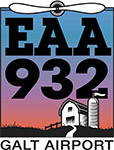I flew home from Louisville, KY, recently and the TAFs indicated the weather in the Chicago area would be Marginal Visual Flight Rules (MVFR) until around 10:00 am (MVFR is a sub-category of VFR weather conditions, meaning a cloud ceiling between 1,000 and 3,000 feet and/or visibility 3 – 5 statute miles). After 10:00 am it was supposed to be perfect VFR for the rest of the day.
It wasn’t!
From experience I know you can never rely on the TAFs so I wasn’t completely surprised. I filed IFR and encountered the low cloud layer just south of Joliet. Most of the airports in the area were reporting MVFR conditions with ceilings around 1,100 or 1,200 feet AGL, but some were IFR as low as 900 feet AGL.
Chicago Approach was happy to keep me at 3,000 MSL (in the clouds) until just north of the DuPage VOR and then they vectored me for the RNAV (GPS)-B approach via the initial approach fix (UDZOW). I initiated a 750 FPM descent rate from the final approach fix and broke out of the clouds about a mile east of Wonder Lake in a perfect position to land on runway 27. The winds were about 3 knots and area reports indicated out of the north, but the windsock and our groundspeed indicated they were in fact more like 030°. I opted to land with a slight tailwind instead of circling to runway 9 since no one else was in the pattern at the time.
It all worked out perfectly that day. But if I didn’t have an instrument rating or I wasn’t IFR current and proficient, what options would I have had?
Option 1 — Fly my original route VFR
One option would have been to fly VFR along my planned route from Joliet to the Dupage VOR, then north over Elgin, Algonquin and Crystal Lake to Galt Airport (10C). This would have put me in Class E airspace where you are required to be at least 500 feet below the clouds. Since the ceiling was at about 1,200 feet AGL I would have had to fly at 700 feet AGL over a congested area for more than 50 miles. Complicating the situation, the minimum safe altitudes rule (14 CFR §91.119) dictates that one must remain at least 1,000 feet above the highest obstacle within 2,000 feet horizontal distance of our aircraft over congested areas (except when necessary for take off or landing), which meant that this plan would not have been legal.
Option 2 — Avoid congested areas
Another choice would have been to change my route to avoid the congested areas. This would have taken me west of DuPage before continuing north towards Galt. I think it would be unlikely that I would get a clearance to fly directly through Aurora’s airspace at 700 feet AGL, but could I have asked for a Special VFR clearance you ask? The answer is “no.” SVFR is only an option for VFR pilots when the airport is reported as Instrument Meteorological Conditions (IMC) (cloud ceiling below 1,000 feet and/or visibility less than 3 statute miles). If the clouds had been just a couple of hundred feet lower I could have requested a SVFR clearance through that Class D airspace and flown at about 900 feet AGL, but that would not have helped me along the rest of my route.
Option 3 — Fly even further to the west
Being familiar with the terrain I know that west of DuPage all the way north to Woodstock is flat and comprised mainly of soy bean and corn fields. Over this type of area §91.119 says we can fly as low as 500 feet above the surface. If I did that I would have been in Class G airspace, which is the airspace from the surface up to, but not including 700 feet AGL. In Class G, the basic VFR weather minimums during the day are 1 statute mile visibility and clear of clouds.
This would have been legal, however, in my humble opinion, definitely not safe. At such a low altitude it would have been difficult to avoid hazards such as power lines and towers and insufficient altitude to find a suitable site for landing in the event of an engine failure.
Option 4 —Delay my flight
Without an instrument rating this would probably have been the best plan. I could have stayed in Louisville an extra day or got as close to my destination as possible in good VFR weather and waited for the weather to improve before flying home. On this day Kankakee (KIKK) would have been the best place to land.
You may think an instrument rating is only required when the conditions are IFR, but this was one example when I really needed it even in a VFR situation.
Beth Rehm, CFII

